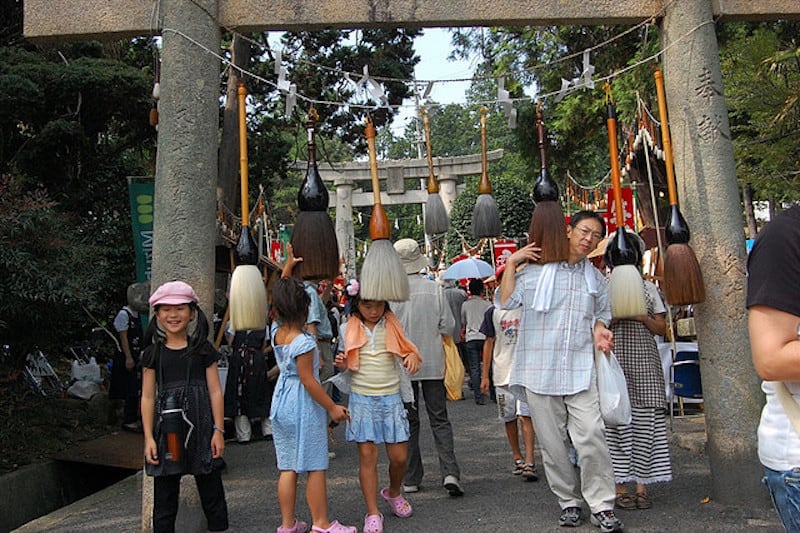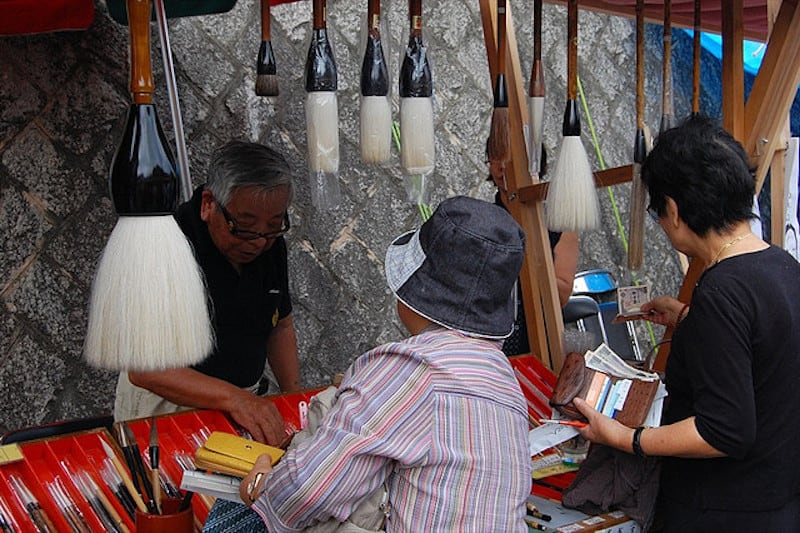With Life on Paper – Kumano Fude Festival
The small town of Kumano, east of Hiroshima city produces the bulk of Japan’s calligraphy brushes (fude).
Every autumn, the townspeople pay thanks to the product that has put them on the map. This year Sofie Ivan Andersen went to join them.
There is a Hungarian proverb that goes,
“Man was given a tongue with which to speak and words to hide his thoughts.”

I don’t know if there is a corresponding Hungarian proverb relating to handwriting. I hope there is. Because calligraphy is the body language of the written word, something understood well here in Japan.
A few years ago I heard it summed up by a Japanese master calligrapher. I don’t remember his name, but I do remember his words: “In Japan, one stroke is beautiful,” he said.

What he meant was that you put all your days and years of practise and all your feelings into that one stroke. One stroke, in theory, can be the essence of what you want to say. Or, as Fuyuki Yoshida, a manager at brush manufacturer Chikuho-do, chooses, “A brush dances to the wind of the heart.”
Everyone it seems, has their own favourite quote about writing here in Kumano, a small town about an hour’s bus ride away from Hiroshima city. It is the unassuming national centre of production for the brushes that are so necessary for the skilful art of writing – and applying makeup.
Once a year then, it is only fitting that people should go out, dress up the shrine in a thousand brushes, do their own calligraphy and watch that of masters, and generally celebrate the joy of writing.
For myself, this was a wonderful experience. Calligraphy is a hobby of mine, so it was gratifying to see other people do stuff that I have always wanted to do but never dared for fear of looking a little nutty and obsessive.
Stuff like:
Touching brushes. Stroking them. They were hung up for this express purpose at the torii entrance of the Sakakiyama Shrine.

Ritually burning old brushes in a cremation-like activity rather than simply throwing them in the bin, saying a prayer of thanks before sending them on their ashy way.

Drooling at the selection of brand new brushes, lingering for hours at the numerous stalls lined up around the shrine.

Buying two candied apples. Okay this has little to do with brushes, but they were my first this millennium, and my goodness, they were delicious.

As was the takoyaki and the kakigori (flavour: blue).
You may laugh, but as anyone who knows anything about Japanese festivals will tell you, the food is key. In fact, most people go to festivals for the food, don’t they? Well, at Kumano, the selection and quality was just sublime. Chinese, Korean, and of course all the Japanese staples consisting mainly of various stuff on sticks. All fresh, clean, delicious, and cheap.
In fact, I went home with a bag of yakisoba, fatty pork and that extra candied apple, it was so good!
It wasn’t just my belly that was cheered by this festival though. I went home feeling really happy, and I don’t think it’s just because I love writing and calligraphy so much.
In fact I missed a lot of the events I’d looked forward to (like the dancing) and some of the ones I did catch were a little disappointing, like the float, which wasn’t a giant brush or anything, just …a float. Always good to see other people work, though.

However, completely disregarding the specific events (which for me were, overall, cathartic) and just looking at the “festival basics,” stuff that applies to every Japanese festival, I have to say that this still is by far the best Japanese festival I have ever been to.
This is because of
- The food. Did I mention the food? The food was really good, you know.
- The people. I was approached by several helpers who were eager to, well, help. Also, when I ventured away from the main sites I found that everyone (yes even children and old women) said a friendly “konnichiwa,”. There was none of the staring (no, not even from children or old women!) that often comes with being an alien in the countryside.
- The event space and turnout. Centred around neighbouring Sakakiyama Shrine and Kumano Middle School, the space was spread out yet it was easy to walk everywhere. And the amount of people was just right. Not too many, which is a pretty bad problem with city festivals, especially the stifling Tokasan.
- The weather. It’s officially autumn, everyone! It makes it so much more fun to be out festivaling when you don’t feel like a clammy clam in a clamshell.
That’s it. I am now home, tired and happy with a slightly upset belly. I leave you with the final giant calligraphy the artist created (again, I am sorry I missed his name): Can anyone read it? If anyone knows what it says (or the name of the man who did it) I would love to know.

See all of Sofie’s photos from the Fude Matsuri on Flickr here.
- See photos from the Fude Matsuri on GetHiroshima here.
- See videos from the Fude Matsuri on GetHiroshima here
- The official Fude Matsuri site is here (Japanese only, but some nice photos).
The Fude Matsuri is held every year on the autumnal equinox, a national holiday in Japan, which usually falls on either September 22 or 23. Kumano is 45 minutes by bus from Hiroshima JR Station (platform 13) and 35 minutes from Kure JR Station (platform 2)











